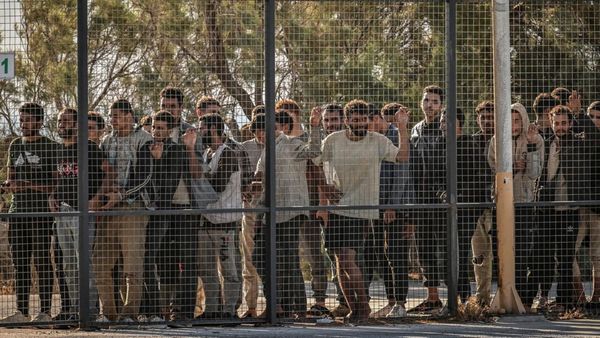
City councillors face a crucial vote on a new $683 million stadium. David Williams reports
Remember when Springfield built a monorail?
No, not the small town west of Christchurch, but the hometown of cartoon family the Simpsons – from a memorable episode in series four called Marge vs. the Monorail.
In it, the people of Springfield meet to decide how to spend a $3 million fine from Mr Burns, who was caught illegally dumping nuclear waste.
Smooth-talking stranger Lyle Lanley convinces them to build a needless monorail. While playing piano on stage, he says: “I swear it’s Springfield’s only choice, throw up your hands and raise your voice.”
Concerned, Marge Simpson gets to her feet: “But Main Street’s still all cracked and broken.”
Son Bart responds: “Sorry, mom, the mob has spoken.”
The crowd bursts onto the town hall steps, singing: “Monorail!”
(Spoiler alert: Lanley was a con artist and building a monorail turned out to be a bad idea.)
Christchurch accountant Cam Preston, who lives in Richmond, a suburb just north-east of the four avenues surrounding the central city, reckons there are parallels between Springfield’s monorail and Christchurch’s mooted 30,000-seat stadium, Te Kaha.
Christchurch came into some money, recently – $300 million from the Government, a 2017 election sweetener dubbed the Christchurch Regeneration Acceleration Fund.
The townspeople – well, the city councillors, at least – decided to spend most of it, $220 million to be exact, on a new stadium.
However, because of the 2010 and 2011 earthquakes, many of the city’s roads and footpaths remain damaged.
(The Christchurch version of this story has no Lyle Lanley character, and there are no allegations of corruption.)
Preston isn’t anti-stadium. He likes attending sports games, and says Christchurch should have a new one to replace the old, demolished Lancaster Park, which was damaged in the earthquakes.
But he worries about the economic benefits of a stadium, which were dubious before the latest cost blowout, at 86 cents for each dollar spent, and are even more doubtful now.
There are also lessons from Dunedin, including council-owned company Aurora deferring maintenance on dangerous power poles so it, and sister company Delta, could pay $30 million to support the city’s stadium.
Experts say the biggest benefit of building a stadium is intangible – it makes people happy.
Preston says: “It’s like the old Simpsons monorail episode, you know, where these things have never proven to be worth the dollars that go into them.”
This week is crucial to Te Kaha.
Tomorrow, councillors will vote on whether to spend an extra $150 million, based on a fixed price contract of $683 million announced yesterday.
(The other options are to stop the project altogether, or pause and re-evaluate it.)
But, complains Preston, his Richmond street’s all cracked and broken.
The mob – rallied by the likes of Canterbury Rugby and the local chamber of commerce – appears to have spoken, however. Three-quarters of 30,000 submissions supported the project.
Preston made an online submission – clicking the “pause” button – but reckons the scrum was probably screwed by highly motivated vested interests.
Leeann Watson, the chamber’s chief executive was adamant, “The only option is to build it”, quite close to Lyle Lanley’s “I swear it’s Springfield’s only choice”. Social media comments warn it’s local body election year and, if the stadium vote isn’t positive, it’s time for a clearout.
It seems all roads lead to a new stadium for Christchurch. But, Preston asks, do some of those roads, including his, have to remain broken?

Preston, who didn’t want to be photographed for this story, isn’t some garden-variety, anonymous accountant.
He became the No. 1 enemy of Southern Response, so much so the government-owned, post-quake insurer paid security firm Thompson & Clark to spy on him and other earthquake claimants between 2014 and 2017.
A 2018 Newshub story into the affair sparked a public inquiry, which found such behaviour, spread across several government agencies, was an “affront to democracy”.
Preston, who has taken contracts for several government agencies, spent hours delving into correspondence between Southern Response and various arms of government, including Treasury, and the offices of the earthquake recovery minister and prime minister.
Once again, in this case, he’s pored over council documents, Cabinet papers, and emails.
If something doesn’t look quite right he goes looking for what he calls the strands of truth. “The whole thing unwinds in front of you.”
On June 30, he emailed his findings to the Mayor Lianne Dalziel and councillors. None replied, so he contacted Newsroom.
Preston traverses the tortured history of the stadium project.
Importantly, a cost-sharing agreement, signed by the council and the Crown in 2013, just months before that year’s local body elections, capped the council’s contribution to the stadium at $253 million.
Its configuration – the number of seats, whether it would be roofed – was reliant on a 2016 business case, and funding sources were unclear. The stadium was meant to be built by the middle of 2017.
But the cost agreement with the Crown left the council with a financial hole – estimated at $413 million in 2014 – for fixing “horizontal infrastructure”, which means roads and water-related infrastructure, including underground pipes.
The 2015 long-term plan estimated a $1.2 billion shortfall over the next 10 years.
Heading into the 2017 election, the Crown hadn’t even bought the final properties on the proposed stadium site – something only sorted last year.
On the campaign trail, Labour pledged $300 million for Christchurch’s earthquake recovery, a promise confirmed in the following year’s Budget.
This commitment was to be part of the so-called “global settlement”, signed in 2019, assigning post-quake work, responsibilities and ownership between the Crown and council. In the settlement, described by those in Wellington as a transition to full local leadership, the Crown said it had met its obligations relating to horizontal infrastructure.
(Preston’s annoyed the city’s problems after the cost-sharing agreement seemed to be compounded by the global settlement.)
“The whole thing was doomed from the start.” – Cam Preston
Councillors decided to split the regeneration fund thus: $220 million for the stadium, $40 million for red zone development, and $40 million for earthquake-damaged roads and footpaths.
The problem, as revealed by correspondence released under the Official Information Act, is Treasury warned council months earlier it couldn’t use the money for damaged roads.
In July 2018, Treasury consultant John Beaglehole told council general manager Brendan Anstiss including roads as a regenerative investment was a “slightly trickier issue” than other possible projects. Anstiss offered to “whip up a spirit level to confirm that roads do (excepting bumps) run horizontally”.
Later that month, Beaglehole sent the proposed eligibility criteria for the fund, including a note that roading “cannot be predominantly or solely related to renewing, repairing, or maintaining existing roading, or other business as usual local authority responsibilities”.
Anstiss replied that “doesn’t make sense to me”. The following week, he said if confirmed the condition would lead to “perverse outcomes” – providing funding for “low priority or made-up works”.
He suggested alternative wording, but Treasury retained the status quo – as noted in an August 2018 Cabinet paper – because of what Beaglehole called “the precedent risk”.
Yet the following month, in a paper prepared by Anstiss, city councillors were asked to endorse a $40 million bid against the government fund “to deliver greater levels of roading and footpath repairs”.
The council nominated five badly-hit suburbs, one of which was Richmond, where Preston lives.
“The whole thing was doomed from the start,” he says. “Some of the recommendations that are put in front of the elected representatives, I almost feel a little bit sorry for them.”
While flawed, Anstiss’s September 2018 paper outlined crucial background on roads.
It said despite hundreds of millions of dollars being spent on repairs, reinstatement, renewals and maintenance since 2011, the condition of Christchurch roads continued to deteriorate.
“Prior to the earthquakes, 9 percent of the roading network was in the lowest condition category (condition 5), however, post-earthquakes this increased to 15 percent in the lowest condition category, and has doggedly remained at this level since.”
The council’s decision, earlier that year, to put an extra $9 million into resurfacing roads would only maintain the status quo, Anstiss said.
Officials from Treasury, the Department of Prime Minister and Cabinet and NZ Transport Agency met city councillors Pauline Cotter and Mike Davidson in March 2019. They suggested work aimed at “safety, traffic calming, modal shifting and increasing use of public transport” would be consistent with the Government’s priorities, and be eligible for Crown funding.
Or as Anstiss put it, “low priority or made-up works”.
That’s not to say this work isn’t welcomed, but it’s not what some neighbourhoods were promised. “They are nice to haves, not required works,” Preston said in his email to councillors, which noted some “condition 5” roads would miss out.
Also, Richmond’s previously earmarked $5 million for munted roads was reduced to $4 million.
In the council’s latest residents’ survey, 27 percent of people are satisfied with the condition of roads, and 35 percent with the condition of footpaths.
Yet, tomorrow councillors will vote on a $683 million stadium ($220 million from the Crown), while Preston’s road, and others, languish in their earthquake-damaged state.
The average residential property will pay $144 a year for the stadium between 2025 and 2027, and lesser amounts over 30 years as debt’s paid off.
According to its 10-year plan produced last year, before the stadium budget blowout, in 2031 the council will be making debt and interest payments of $251 million, on total debt of $3.6 billion.
“I can’t see why we would rack up some more debt to put a roof on a luxury item when we can’t even fund the basic maintenance and renewal of roads,” Preston says.
Renewal back to BAU
Davidson, the Papanui ward councillor who met government officials about road repairs in 2019, chairs the urban development and transport committee. He says Preston’s road will be placed on a business-as-usual renewal programme.
“The reality is that funding can only stretch so far and following engagement with our community, the decision was made by our local community board where to invest the money.
“We had already secured around $11.3 million of investment into the streets of Richmond ($3.8m has been spent to date and $7.5m is planned for future works), so the additional $4m, while not the $5m originally envisioned, will provide $15.3m of transport infrastructure investment in Richmond that will create excellent outcomes for the community.”
Cotter, of the Innes ward (including Richmond), adds: “The resulting decision has involved copious hours of work and meetings, so was not arrived at lightly.”
Both councillors were silent on whether the council has an obligation to fix more city roads before pursuing an expensive, roofed stadium. There’s also the nose-bothering matter of the pong from the city’s fire-damaged wastewater treatment plant.
The council’s “thematic analysis” of annual plan submissions noted: “Residents in the east are feeling increasingly frustrated by our spending on things perceived as ‘nice to haves’ when they feel that they are continuously having to fight to get investment in some of the basics.”
The council’s general services satisfaction survey, of 773 people, said 26 percent of people, an increase from 22 percent a year ago, made a negative comment about the state of roads.
One anonymous surveyed respondent said: “Many roads are still rough and have never been attended to since 2011.”
Another city councillor, Yani Johanson, who represents Linwood, told Newsroom he shares concerns about how long repairs are taking for the city’s munted roads and footpaths.
“The cost of not fixing our broken roads and footpaths in the east is a false economy,” he says via email. “The longer we leave renewing or repairing them properly, the higher the cost will be in both reactive maintenance and cost to fix.”
“In my personal view, council should not continue to gold-plate the central city at the expense of fixing the basics in the suburbs and we need to reprioritise.”
In a response from council staff, head of transport and waste management Lynette Ellis says the council submitted its business case for the Christchurch regeneration acceleration fund in November 2019.
(The council’s agenda item from the previous month says roading and transport improvements under the $40 million portion “will improve safety outcomes and encourage more people to walk, cycle or take public transport”. Within the five nominated suburban areas, up to $30 million would be spent “to address three key issues of accessibility, safety and asset condition”.)
The council received $80 million from the government, for red zone and road works, in March 2020, Ellis says.
“We then undertook a consultation process and we are now working on prioritisation of the works/projects from the investment case with the individual community boards.
“The final prioritisation of the works … is the responsibility of the relevant community boards.”
Ellis says about $3 million of the $40 million funding for roads has been spent. “This has gone towards investigating, consulting and implementing road safety priorities, public transport network improvements, and roading and transport improvements.”
Council chief executive Dawn Baxendale says in a statement: “Council is taking a responsible approach to our improvements, renewals and maintenance and we have developed very sensible 10 year+ plans.”
Many things still baffle Richmond accountant Preston, such as the need for a roof on the stadium, and why this batch of councillors would make such an important decision so close to an election – especially when Dalziel, the mayor, has complained so bitterly about being locked into the cost-sharing agreement signed months before she was elected.
“Look, no one is going to say no to a stadium,” he tells Newsroom. “It’s like going out and consulting with the public about whether they should cancel Christmas or not.”
The city needs a stadium, he says. The decision comes down to whether there should be a ceiling – “excuse the pun” – on the project, either a maximum dollar value or the number of seats.
(Newsroom talked to Preston last Friday, before yesterday’s announcement of a fixed price contract. Via email last night, Preston says: “A fixed price will simply mean a higher price again, as standard practice is to just price-in a massive contingency for escalation.”)
How will this turbulent episode end? It seems unlikely councillors will cancel the stadium, having already spent $40 million, so that leaves borrowing an extra $150 million, or pausing and re-evaluating.
One big tension is the looming local body elections. Will councillors who are re-standing worry that voting “against” the stadium will cost them in October? And will any of them, including Dalziel, feel it’s unfair to lock a new council into a decision?
Going back to The Simpsons, when Springfield built its monorail in the 1993 episode, predictably Homer was its conductor. Thanks to Marge’s sleuthing, complete disaster was averted.
She concludes with a searing commentary on city decisions: “And that was the only folly the people of Springfield ever embarked upon. Except for the popsicle-stick skyscraper, and the 50-foot magnifying glass, and that escalator to nowhere.”







